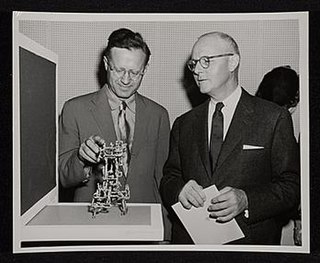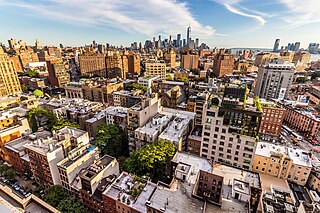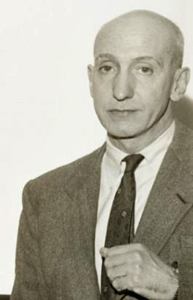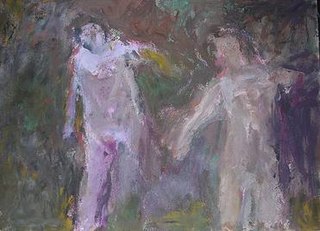Related Research Articles
Abstract expressionism is a post–World War II art movement in American painting, developed in New York City in the 1940s. It was the first specifically American movement to achieve international influence and put New York at the center of the Western art world, a role formerly filled by Paris.
The New York School was an informal group of American poets, painters, dancers, and musicians active in the 1950s and 1960s in New York City. They often drew inspiration from surrealism and the contemporary avant-garde art movements, in particular action painting, abstract expressionism, jazz, improvisational theater, experimental music, and the interaction of friends in the New York City art world's vanguard circle.

Elaine Marie Catherine de Kooning was an Abstract Expressionist and Figurative Expressionist painter in the post-World War II era. She wrote extensively on the art of the period and was an editorial associate for Art News magazine.

Ibram Lassaw was a Russian-American sculptor, known for non-objective construction in brazed metals.
Albert Kotin belonged to the early generation of New York School Abstract Expressionist artists whose artistic innovation by the 1950s had been recognized across the Atlantic, including in Paris. The New York School Abstract Expressionism, represented by Jackson Pollock, Willem de Kooning, Franz Kline, and others became a leading art movement of the post-World War II era.

The 9th Street Art Exhibition of Paintings and Sculpture is the official title artist Franz Kline hand-lettered onto the poster he designed for the Ninth Street Show. Now considered historic, the artist-led exhibition marked the formal debut of Abstract Expressionism, and the first American art movement with international influence. The School of Paris, long the headquarters of the global art market, typically launched new movements, so there was both financial and cultural fall-out when all the excitement was suddenly emanating from New York. The post-war New York avant-garde, artists like Willem de Kooning and Jackson Pollock, would soon become "art stars," commanding large sums and international attention. The Ninth Street Show marked their "stepping-out," and that of nearly 75 other artists, including Harry Jackson, Helen Frankenthaler, Joan Mitchell, Grace Hartigan, Robert De Niro Sr., Philip Guston, Elaine de Kooning, Lee Krasner, Franz Kline, Ad Reinhardt, David Smith, Milton Resnick, Joop Sanders, Robert Motherwell, Barnett Newman and many others who were then mostly unknown to an art establishment that ignored experimental art without a ready market.
James Rosati was an American abstract sculptor. He is best known for creating an outdoor sculpture in New York: a stainless steel Ideogram.

New York Figurative Expressionism is a visual arts movement and a branch of American Figurative Expressionism. Though the movement dates to the 1930s, it was not formally classified as "figurative expressionism" until the term arose as a counter-distinction to the New York-based postwar movement known as Abstract Expressionism.
Michael Goldberg was an American abstract expressionist painter and teacher known for his gestural action paintings, abstractions and still-life paintings. A retrospective show, "Abstraction Over Time: The Paintings of Michael Goldberg", was shown at MOCA Jacksonville in Florida from 9/21/13 to 1/5/14. His work was seen in September 2007 in a solo exhibition at Knoedler & Company in New York City, as well as several exhibitions at Manny Silverman Gallery in Los Angeles. Additionally, a survey of Goldberg's work is exhibited at the University Art Museum at California State University, Long Beach since September 2010.

Nicolas Carone belonged to the early generation of New York School Abstract Expressionist artists. Their artistic innovation by the 1950s had been recognized internationally, including in London and Paris. New York School Abstract Expressionism, represented by Jackson Pollock, Willem de Kooning, Franz Kline, Conrad Marca-Relli and others, became a leading art movement of the postwar era.
Madison Fred Mitchell belonged to the New York School Abstract Expressionist artists whose influence and artistic innovation by the 1950s had been recognized around the world. New York School Abstract Expressionism, represented by Jackson Pollock, Willem de Kooning, Franz Kline and others became a leading art movement of the post-World War II era.
Irving Sandler was an American art critic, art historian, and educator. He provided numerous first hand accounts of American art, beginning with abstract expressionism in the 1950s. He also managed the Tanager Gallery downtown and co-ordinated the New York Artists Club of the New York School from 1955 to its demise in 1962 as well as documenting numerous conversations at the Cedar Street Tavern and other art venues. Al Held named him, "Our Boswell of the New York scene," and Frank O'Hara immortalized him as the "balayeur des artistes" because of Sandler's constant presence and habit of taking notes at art world events. Sandler saw himself as an impartial observer of this period, as opposed to polemical advocates such as Clement Greenberg and Harold Rosenberg.

Joop Sanders is a Dutch-American painter, educator, and founding member of the American Abstract Expressionist group. He is the youngest member of the first generation of the New York School.

American Figurative Expressionism is a 20th-century visual art style or movement that first took hold in Boston, and later spread throughout the United States. Critics dating back to the origins of Expressionism have often found it hard to define. One description, however, classifies it as a Humanist philosophy, since it's human-centered and rationalist. Its formal approach to the handling of paint and space is often considered a defining feature, too, as is its radical, rather than reactionary, commitment to the figure.

Mary Lee Abbott was an American artist, known as a member of the New York School of abstract expressionists in the late 1940s and 1950s. Her abstract and figurative work were also influenced by her time spent in Saint Croix and Haiti, where she lived off and on throughout the 1950s.

George McNeil was an American abstract expressionist painter.

Milton Resnick was an American artist noted for abstract paintings that coupled scale with density of incident. It was not uncommon for some of the largest paintings to weigh in excess three hundred pounds, almost all of it pigment. He had a long and varied career, lasting about sixty-five years. He produced at least eight hundred canvases and eight thousand works on paper and board.
Natalie Edgar is an American abstract expressionist painter, a former critic for ARTnews, and a key writer and historian on the birth and development of abstract expressionism.
The Club has been called "a schoolhouse of sorts ... as well as a theater, gallery space, and a dancehall...." Created by abstract expressionist sculptor Philip Pavia, The Club grew out of the informal gatherings among dozens of painters and sculptors who all had art studios in Lower Manhattan between 8th and 12th streets and First and Sixth Avenues during the late 1940s and early 1950s. Membership included many of New York's most important mid-century artists and thinkers, predominantly painters and sculptors like Willem de Kooning, Franz Kline, Isamu Noguchi, John Ferren, and Robert Motherwell, as well as nearly all the artists later called the New York School. But other celebrated artists, cultural figures and major 20th-century thinkers attended meetings, including philosopher Joseph Campbell, composer John Cage and political theorist Hannah Arendt. Structured to facilitate the growth and dissemination of ideas about art by artists for artists, especially abstract expressionist art, The Club lent New York's art scene the vitality and international influence Paris had long monopolized, and U.S. artists had long craved.
It is. A Magazine for Abstract Art was an influential limited edition fine arts magazine that only published six issues in its seven years of existence. Founded by the abstract expressionist sculptor Philip Pavia, the magazine's contributors included a who's who of some of the 20th century's most important artists. Although it primarily focused on painters and sculptors like Willem de Kooning, Franz Kline, Helen Frankenthaler, Jackson Pollock and Isamu Noguchi, it also published artists of other kinds, like musician John Cage and poet Allen Ginsberg. Collectively, the magazines served to catalyze, and catalogue, the contemporaneous life cycle of abstract expressionist thought, from creation to mature expression. Reference to the magazine appears in the archives of Picasso, Motherwell and André Breton, as well as collector Peggy Guggenheim, critic Clement Greenberg and nearly two dozen others.
References
- 1 2 3 "Avant-Garde Sculptor Philip Pavia 94 Dies". Art Daily. Sep 21, 2018.
- 1 2 Moss, Drew (July 7, 2016). "Philip Pavia Turned Rocks Into Art". Long Island Pulse.
- 1 2 3 4 5 6 7 8 9 "Philip Pavia: Sculptor and champion of Abstract Expressionism who did much to shift the epicentre of Modernism from Paris to New York". The Times. May 23, 2005.
- ↑ "High Seas". Williams College Museum of Art. Retrieved 2021-11-19.
- ↑ MassLive, The Associated Press | (2010-09-29). "MoMA mounts its largest presentation of abstract expressionist art". masslive. Retrieved 2021-11-22.
- ↑ "Pavia, Philip, 1915-2005 - Social Networks and Archival Context". snaccooperative.org. Retrieved 2021-11-22.
- 1 2 3 4 5 6 Bui, Phong (Feb 1, 2001). "The Club IT IS: A Conversation with Philip Pavia". The Brooklyn Rail.
- ↑ Diggory, Terence (2009). Encyclopedia of the New York School Poets. Facts on File Literary Movements. p. 224. ISBN 978-0-8160-5743-6
- ↑ "The Shows That Made Contemporary Art History: The Ninth Street Show". Artland Magazine. 2020-10-30. Retrieved 2021-11-22.
- ↑ "The exhibition that pushed NYC to the art world's centre | art | Phaidon". www.phaidon.com. Retrieved 2021-11-22.
- 1 2 Bui, Phong (Dec 10, 2005). "A Tribute to Philip Pavia (1912-2005)". The Brooklyn Rail. Retrieved 2014-06-12.
- 1 2 Glueck, Grace (Aug 4, 1971). "Sculptures Come Out 'Into Environment'". The New York Times.
- ↑ Sisario, Ben (2005-04-15). "Philip Pavia, 94, an Avant-Garde Sculptor, Is Dead". The New York Times. ISSN 0362-4331 . Retrieved 2021-11-19.
- ↑ "Pavia, Philip". Connecticut State Library. July 22, 2015. Retrieved Jan 25, 2019.
- ↑ Brenson, Michael (1987-04-03). "ART: WORKS BY GOURFAIN AT BROOKLYN MUSEUM". The New York Times. ISSN 0362-4331 . Retrieved 2021-11-20.
- ↑ "Philip Pavia Chronology/Bibliography/Collections". Philip Pavia Website.
- ↑ "Pavia 'scatter' sculpture graces North Campus". www.buffalo.edu. Retrieved 2021-11-19.
- ↑ Russell, John (1982-11-12). "ART: MARDEN ON MARBLE, ON CANVAS AND ON PAPER". The New York Times. ISSN 0362-4331 . Retrieved 2021-11-20.
- ↑ Archives of American Art. "The Club records kept by Philip Pavia, 1948-1965 | Archives of American Art, Smithsonian Institution". Archives of American Art. Smithsonian. Retrieved 2014-06-12.
- ↑ Associated Press (April 17, 2005). "Philip Pavia, 94, pioneer sculptor". The Boston Globe.
- 1 2 3 4 Larson, Kay (Dec 15, 2002). "ART/ARCHITECTURE; The Art Was Abstract, the Memories Are Concrete". The New York Times.
- ↑ Brown, Devin (Aug 15, 2013). "On Not Becoming Loners and Fading Away: An Overview of the Philip Pavia and Natalie Edgar Archive of Abstract Expressionist Art". Burnaway.
- ↑ Smith, Roberta (1991-08-26). "Reviews/Television; Robert Motherwell's Achievements". The New York Times. ISSN 0362-4331 . Retrieved 2021-11-20.
- ↑ Pavia, Philip (2004). "PAVIA, PHILIP, 1915-2005. Philip Pavia and Natalie Edgar archive of abstract expressionist art, 1913-2005". Emory University, Stuart A. Rose Manuscript, Archives, and Rare Book Library.
- ↑ Edgar, Natalie (2007). Club Without Walls: Selections from the Journals of Philip Pavia. Midmarch Arts Press. ISBN 978-1877675645. OCLC 892155223.
- ↑ Platzker, David. "It Is: A Magazine for Abstract Art — Specific Object". Specific Object.
- ↑ Archives of American Art (1965). "The Club records kept by Philip Pavia, 1948-1965". Smithsonian.
- ↑ Pavia, Philip. "An Open Letter to Leslie Katz, Publisher of Arts Magazine, New York City". It is: A Magazine for Abstract Art. (Autumn 1959): 79.
- ↑ Curtis, Cathy. A generous vision: the creative life of Elaine de Kooning.
- ↑ Hooten, Bruce (Jan 19, 1965). "Oral history interview with Philip Pavia, 1965 Jan. 19". Archives of American Art.
- ↑ "Philip Pavia | Albright-Knox". Albright-Knox Art Gallery. Retrieved 2018-09-20.
- ↑ "Museum Outdoor Sculpture Collection | Hofstra | New York". www.hofstra.edu. Sep 21, 2018. Retrieved 2018-09-20.
- ↑ "All National Academicians (1825 - Present)". National Academy of Design. Sep 21, 2018. Retrieved 2018-09-20.
- ↑ "Search | The Metropolitan Museum of Art". The Metropolitan Museum of Art. Metmuseum.org. Sep 21, 2018. Retrieved 2014-06-12.
- ↑ "PAVIA Philip, Artisti in Collezione | Museo dei Bozzetti". www.museodeibozzetti.it (in Italian). Sep 21, 2018. Retrieved 2018-09-20.
- ↑ "Musma - Matera - La somparsa di Ellen Russotto". www.musma.it (in Italian). Sep 21, 2018. Retrieved 2018-09-20.
- ↑ "Philip Pavia". Smithsonian American Art Museum. Sep 21, 2018. Retrieved 2018-09-20.
- ↑ Gabriel, Mary (September 25, 2018). Ninth Street Women: Lee Krasner, Elaine de Kooning, Grace Hartigan, Joan Mitchell, and Helen Frankenthaler: Five Painters and the Movement That Changed Modern Art. New York: Little, Brown and Company. ISBN 978-0316226189.
- ↑ Starr Staff (Sep 20, 2012). "Luigi Pavia, 44, 'a Talent for Friendship'". The East Hampton Star. Retrieved Nov 13, 2018.
- ↑ Segal, Mark (Jan 19, 2017). "Paul Pavia's Small Sculptures Recall Great Monoliths". The East Hampton Star. Retrieved Nov 13, 2018.